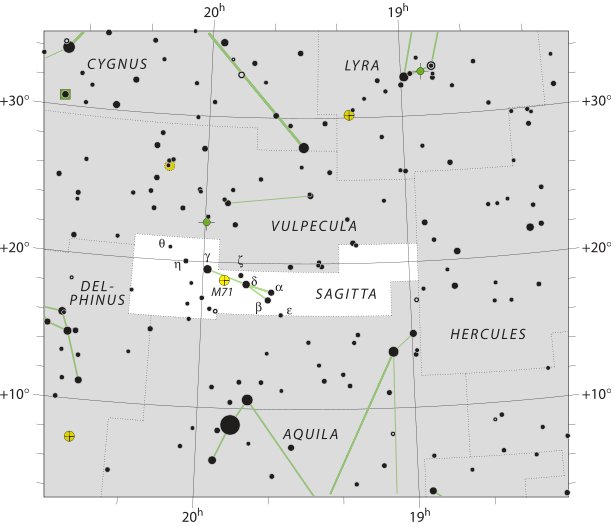There are 7 more
stars in the Sagitta
constellation.
(What looks like
an
omikron star,
ο, in the map below is
not mentioned
in the
list of
Wikipedia, nor
anywhere else
where I have
looked).
|
ε |
19h 37m 17.38s |
19h 37.230m |
298.1 |
|
Sham |
19h 40m 05.78s |
19h 40.096m |
298.8 |
|
β |
19h 41m 02.93s |
19h 41.049m |
299.0 |
|
δ |
19h 47m 23.27s |
19h 47.388m |
300.6 |
|
ζ |
19h 48m 58.65s |
19h 48.978m |
301.1 |
|
γ |
19h 58m 45.39s |
19h 58.757m |
303.5 |
|
η |
20h 05m 09.47s |
20h 05.158m |
305.2 |
|
θ |
20h 09m 56.61s |
20h 09.944m |
306.4 |
|
Ardra 23 |
24 (85) |
25 |
Punarvasu
1 |
|
Heka 1 |
2 |
3 |
4 (57) |
|
July 9 |
10 |
11 |
12 (193) |
 |
 |
 |
 |
|
Cb4-13 |
Cb4-14
(477) |
Cb4-15 |
Cb4-16 |
|
manu
pao i te
hau tea
- kua tu |
manu
rere ki
te hau
tea -
kua tu |
manu
rere ki
te hau
tea |
kiore
- henua |
|
Wasat
(109.8) |
Aludra
(111.1) |
Gomeisa
(111.6),
ρ Gemini
(112.1) |
Castor
(113.4) |
|
U.
Ashadha
7 |
8 |
9 (270) |
10 |
|
January
9 |
10 |
11 |
12 (377) |
|
Shaula 7 |
8 |
9 (240) |
10 |
|
χ
Sagittarii
(293.6),
Deneb
Okab
(294.0) |
Albireo
(295.5) |
no star
listed |
ε
Sagittae
(297.1) |
|
Punarvasu
2 |
3 |
4 (90) |
5 |
|
Heka 5 |
6 |
7 (60) |
8 |
|
July 13 |
14 |
15 (196) |
16 |
 |
 |
 |
 |
|
Cb4-17
(480) |
Cb4-18 |
Cb4-19 |
Cb4-20 |
|
erua
marama |
tagata
noho i
to mea |
kua
vaha |
|
no star
listed |
Markab
Puppis
(114.7),
Procyon
(114.9) |
σ Gemini
(115.7),
Pollux
(116.2) |
Azmidiske
(117.4) |
|
U.
Ashadha
11 |
Sravana
1 |
2 |
3 (275) |
|
January
13 (378) |
14 |
15 |
16 |
|
Shaula
11 |
12 |
13 (244) |
Al Naam
1 |
|
Sham
(297.7),
β
Sagittae
(298.0) |
Tarazed
(299.3) |
δ
Sagittae
(299.6),
ζ
Sagittae
(300.1),
Altair
(300.3) |
ι
Sagittarii,
Terebellum
(301.2) |
|
Punarvasu
6 |
7 |
8 (94) |
|
Heka 9 |
10 |
11 (64) |
|
July 17 |
18 |
19 (200) |
 |
 |
 |
|
Cb4-21 |
Cb4-22
(485) |
Cb4-23 |
|
te
moa |
tagata -
te maro |
te
tagata |
|
no stars
listed |
Drus
(119.9) |
|
Sravana
4 |
5 (277) |
6 |
|
January
17 |
18 (383) |
19 |
|
Al Naam
2 |
3 |
4 (248) |
|
Alshain
(301.6),
ε
Pavonis,
θ
Sagittarii
(302.3),
γ
Sagittae
(302.5) |
μ
Pavonis
(302.7) |
20h
(304.4) |
|
η
Sagittae
(304.2),
δ
Pavonis
(304.5) |
|
Punarvasu
9 |
10 (96) |
11 |
|
Heka 12
(65) |
13 |
Alhena 1 |
|
July 20 |
21 (202) |
22 |
 |
 |
 |
|
Cb5-1 |
Cb5-2
(488) |
Cb5-3 |
|
Te
ragi |
tagata -
ragi |
kua
hakagana
- ki te
maro |
|
Naos
(121.3),
ρ Puppis
(122.0) |
8h
(121.7) |
Regor
(122.7),
Tegmine
(123.3) |
|
Heap of
Fuel
(122.1) |
|
Sravana
7 |
8 (280) |
9 |
|
January
20 (385) |
21 |
22 |
|
Al Naam
5 (249) |
6 |
7 |
|
Shang
Wei
(305.2),
θ
Sagittae
(305.4) |
ξ
Capricorni
(305.8) |
Gredi
(307.2),
σ
Capricorni
(307.5) |
Above I have
provisionally
kept the manzil
dates of
Wikipedia and
also my rule of
184 days'
difference
between the heliacal
and the
corresponding nakshatra
dates.
Allen:
"Sagitta,
the Arrow,
the French
Flèche, the
German Pfeil,
and the Italian
Saetta,
lies in the
Milky Way,
directly north
of Aquila and
south of Cygnus,
pointing
eastward; and,
although
ancient, is
insignificant,
for it has no
star larger than
the 4th
magnitude, and
none is named.
It has
occasionally
been drawn as
held in the
Eagle's talons,
for the bird was
arrow-bearer to
Jove; but
Eratosthenes
described it
separately, as
Aratos had done,
and as it now is
on our maps ..."
Hevelius
inserted a new
constellation,
the Fox
(Vulpecula)
between the
Eagle (Aquila)
and the upside
down Swan
(Cygnus).

However, his
construction
does not appear
to be of much
value and I will
not, at least
for the moment,
include its
stars in my
list.












